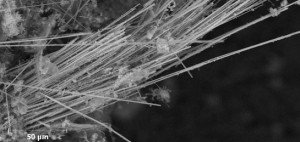Multiple trial courts toss out “single fiber” causation theory under both Federal and state law
June 17, 2015
News and Views on Environmental & Toxic Tort Federal and State Legal Issues and Developments
June 17, 2015
Since the first asbestos filing by a plaintiff’s lawyer, plaintiff medical experts in mesothelioma cases have infamously opined that every exposure to asbestos by a plaintiff – including exposure to a single asbestos fiber – is sufficient to cause disease. Not only does this type of expert testimony ease the connecting of the causation dots, but it permits the recycling of generalized and “boilerplate” expert reports. Recently, however, court rulings have given hope to defendants in the litigation that plaintiffs may now have to put considerably more time and effort into developing their expert opinions by precluding those experts from advancing the “single fiber” theory.
In January 2013,  the District Court of Utah rejected plaintiff’s attempt to use “single fiber” expert testimony. Smith v. Ford Motor Co., D. Utah, No. 2:08-cv-630, 1/18/13. In Smith, Ford moved to dismiss the “single fiber” testimony of plaintiff’s medical expert, arguing that the theory was speculative and without scientific foundation. As a result, it was inadmissible under Federal Rule of Evidence 702 and Daubert v. Merrell Dow Pharmaceuticals Inc., 509 U.S. 579 (1993). The district court agreed and found that the pathologist’s opinion was wholly “unsupported by sufficient or reliable scientific research, data, investigations or studies.” The court elaborated that this testimony did “virtually nothing to help the trier of fact decide the all-important question of specific causation” and is based solely on the belief that any exposure should not be ruled out as a contributing cause. Finally, the court pointed out that the fact that this type of testimony survived Daubert challenges in the past was an “aberration.”
the District Court of Utah rejected plaintiff’s attempt to use “single fiber” expert testimony. Smith v. Ford Motor Co., D. Utah, No. 2:08-cv-630, 1/18/13. In Smith, Ford moved to dismiss the “single fiber” testimony of plaintiff’s medical expert, arguing that the theory was speculative and without scientific foundation. As a result, it was inadmissible under Federal Rule of Evidence 702 and Daubert v. Merrell Dow Pharmaceuticals Inc., 509 U.S. 579 (1993). The district court agreed and found that the pathologist’s opinion was wholly “unsupported by sufficient or reliable scientific research, data, investigations or studies.” The court elaborated that this testimony did “virtually nothing to help the trier of fact decide the all-important question of specific causation” and is based solely on the belief that any exposure should not be ruled out as a contributing cause. Finally, the court pointed out that the fact that this type of testimony survived Daubert challenges in the past was an “aberration.”
In December 2014, the Northern District of Illinois similarly found that this theory was inadmissible under Daubert and Rule 702. In Krik v. Crane Co., No. 10-cv-7435, N.D. Ill. December 12, 2014 (Doc. # 314), the Northern District analyzed the opinions of plaintiff’s medical experts and industrial hygienist, finding that these opinions indeed espoused the “single fiber” theory. In holding that single fiber causation is “not an acceptable approach for a causation expert to take,” the court noted that “single fiber” causation was inconsistent with Illinois’ express adoption of the “frequency, regularity and proximity” causation test in Thacker v. UNR Industries, Inc., 603 N.E.2d 449, 457. Further, the “any exposure” theory was also inadmissible given plaintiff”s experts’ “wholesale failure to based their opinions on facts specific to this case.” In fact, the court specifically pointed out that plaintiff’s experts admitted in their depositions that they had not considered any case-specific facts in formulating their opinions.
In April 2015, a New York court also rejected the single fiber theory, finding that plaintiff’s theory of cumulative, unquantifiable exposure did not pass muster under New York’s rules of evidence. Juni v. A.O. Smith Water Products, No. 19031/12, 2015 WL 1623788 (N.Y. Sup. Ct., N.Y. County Apr. 13, 2015). Specifically, the court found that the “every exposure” testimony was insufficient to prove that any specific exposure was a significant contributing factor to causing the disease. The result? An $11 million verdict against Ford was overturned.
These most recent rejections of the “every exposure” theory are significant victories for defendants because they add to the accumulation of similar rulings across the country. After years of accepting the “every exposure” theory, courts are now requiring that both plaintiff and defense expert opinions be based on case-specific facts grounded in science.